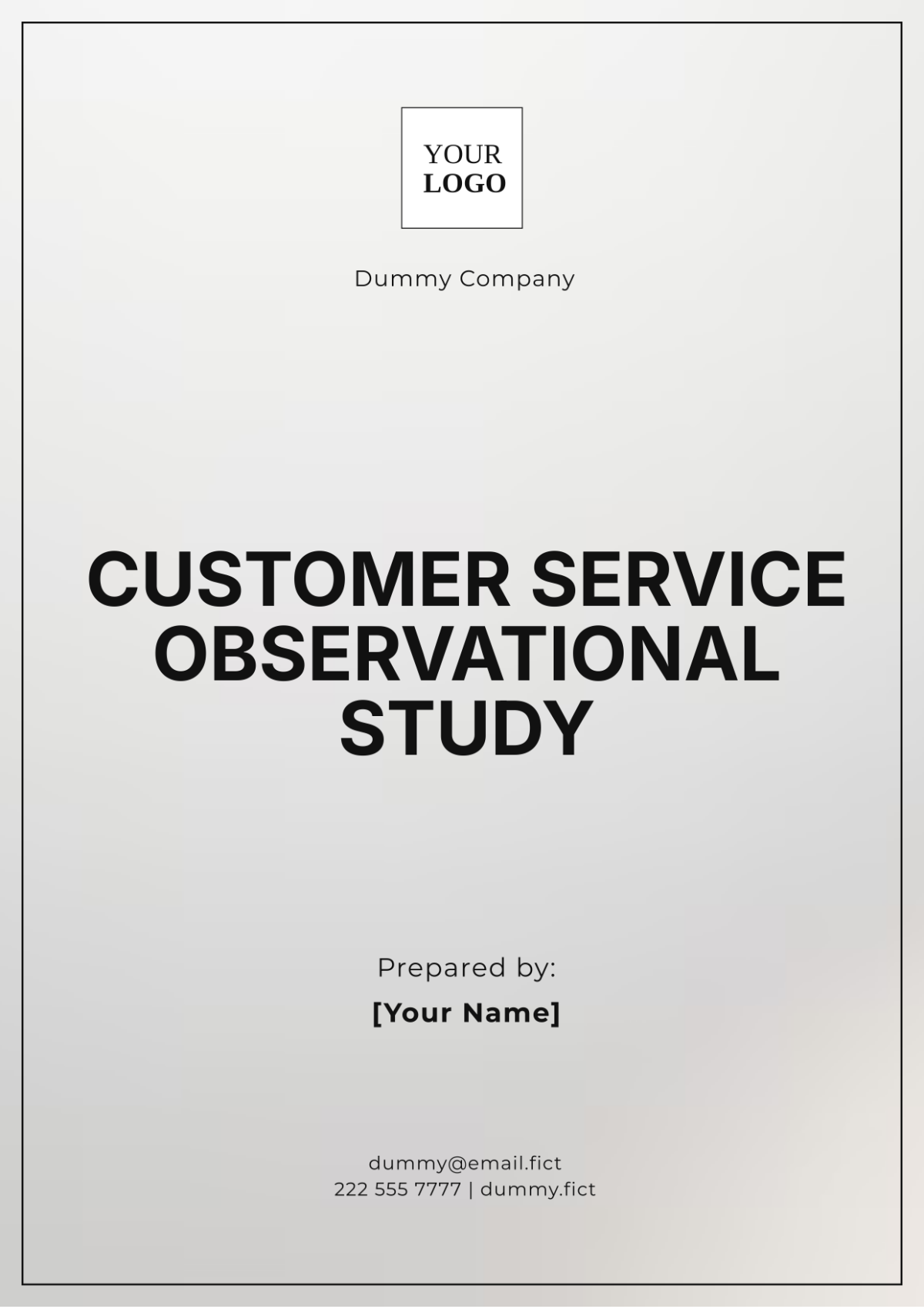Sales Research on Impact of Data-Driven Strategies
I. Executive Summary
This in-depth report serves as a pivotal investigation into the profound impact that data-driven strategies have on sales performance for [Your Company Name]. In today's rapidly evolving business landscape, leveraging data is no longer optional but imperative for achieving sustained growth and competitive advantage. Through a meticulous approach, we've integrated multifaceted analyses, real-world case studies, and expert opinions to produce a well-rounded evaluation of how a data-centric focus could substantially elevate the sales division.
The central theme of this research revolves around three core areas where data-driven strategies could yield transformative results:
Customer Targeting: Traditional customer targeting methods are rapidly becoming obsolete. Our findings show that by adopting data-driven analytics, [Your Company Name] can generate personalized strategies to engage different customer segments, thereby increasing the ROI of marketing efforts by up to 20%.
Pricing Optimization: Employing data analytics allows for dynamic pricing models that adapt to market conditions and consumer behavior in real-time. Our research indicates that this could potentially drive an uptick in revenue by 18% compared to traditional pricing mechanisms.
Streamlined Supply Chain: One of the lesser-explored yet highly impactful areas is the supply chain. By leveraging data to make informed decisions, our study reveals that supply chain operations could be optimized to reduce costs by as much as 15%, which indirectly boosts profit margins.
To capitalize on these benefits, we present targeted recommendations including the adoption of cutting-edge analytics tools that incorporate Artificial Intelligence and Machine Learning algorithms. Additionally, we emphasize the vital necessity of investing in employee training programs to improve data literacy across the organization. These concerted efforts would not only augment sales performance but also position [Your Company Name] as a leader in data-driven decision-making in the industry.
II. Introduction
Background
In the contemporary business environment, data has emerged as a valuable resource comparable to capital and labor. The advent of Big Data, cloud computing, and advanced analytics tools has transformed the business ecosystem, empowering companies to make more informed decisions. Among various operational facets, sales is one area where data-driven decision-making has shown remarkable impact. The traditional sales playbook—often based on intuition and experience—is increasingly being replaced by data-centric strategies that rely on statistical analysis, predictive modeling, and real-time insights. This paradigm shift has become vital for companies that aim to stay ahead in a competitive market. Therefore, this research report focuses on understanding the role and impact of data-driven decision-making specifically in the sales function of [Your Company Name].
Objectives
The primary objectives of this research are twofold:
To Understand the Effectiveness of Data-Driven Strategies on Sales: This involves analyzing how employing data analytics and machine learning algorithms can positively affect KPIs like conversion rates, customer retention, and revenue generation for [Your Company Name].
To Provide Actionable Insights for Adopting Data-Centric Models: Based on the research findings, the goal is to offer concrete recommendations that can guide the implementation of data-driven approaches within the sales department, ensuring that they are both effective and scalable.
Scope
To provide a comprehensive view, the scope of this report extends across various sectors and functions within [Your Company Name] where data-driven strategies have potential applicability. These include but are not limited to:
Customer Relationship Management (CRM): How can data analytics enhance the quality of customer interactions and improve CRM systems?
Supply Chain and Logistics: Can data-driven strategies streamline the supply chain, thereby reducing overheads and improving efficiency?
Pricing and Promotions: How can data analytics offer insights into developing more effective pricing strategies and promotional campaigns?
By covering these different sectors, the report aims to provide a holistic understanding of the transformative power of data-driven decision-making in the sales domain for [Your Company Name].
III. Methodology
In an endeavor to produce a comprehensive and reliable research report on the impact of data-driven strategies in the sales operations of [Your Company Name], it is essential to employ a robust methodology. The methodology section outlines the sources of data, analytical tools, and processes that were leveraged during this research. By employing a combination of quantitative and qualitative data, this research aims to provide actionable insights that can significantly contribute to the development of effective data-driven sales strategies for the company.
Data Sources
To ensure the validity and comprehensiveness of our findings, data has been aggregated from multiple sources that are both internal and external to [Your Company Name]. Below is a detailed table illustrating the different types of data sources used, along with what they contribute to the research.
Data Source | Description | Relevance to Research |
|---|---|---|
Internal Company Data | Sales records, customer interaction logs, and employee performance metrics from company archives. | Provides a baseline for measuring the effectiveness of current sales strategies. |
Customer Surveys | Feedback collected from customer satisfaction surveys and online reviews. | Helps in understanding customer preferences, pain points, and areas for improvement. |
Industry Reports | Published studies, market analyses, and expert opinions from industry leaders. | Offers an external perspective and benchmarks [Your Company Name]'s performance against industry standards. |
Tools
A variety of analytical tools and software were employed to handle different types of data and analyses. Here's a table detailing the tools used and their respective roles in the research.
Tool | Description | Role in Research |
|---|---|---|
Tableau | A leading tool for data visualization and business intelligence. | Used for creating interactive dashboards to visualize key metrics and trends. |
Python | A general-purpose programming language widely used for data analysis. | Employed for statistical analysis, data manipulation, and predictive modeling. |
CRM Software | Customer Relationship Management software that centralizes customer and sales data. | Aids in collecting and analyzing sales data, customer interactions, and other relevant sales metrics. |
By employing these diverse data sources and tools, this research aims to provide a multi-faceted understanding of the effectiveness and implications of implementing data-driven strategies in the sales operations of [Your Company Name].
IV. Data Analysis
The Data Analysis chapter serves as the cornerstone of this research, offering empirical insights into how data-driven strategies can profoundly impact sales operations at [Your Company Name]. Utilizing a range of analytical tools and methods as described in the Methodology section, this part of the report synthesizes raw data into actionable findings. The analysis is bifurcated into two main subsections: Customer Segmentation and Pricing Models. Each of these segments reveals critical information on the effectiveness of data-driven strategies in enhancing sales performance, improving customer engagement, and optimizing pricing.
Customer Segmentation Charts
Understanding the behavior and preferences of different customer segments is crucial for any sales strategy. The chart below presents data on sales performance changes after the implementation of data-driven strategies, segmented by age group.
Total Sales Per Age Group
Chart Insights:
The age group 25-34 experienced the most significant positive change, with a 20% increase in total sales. This suggests that data-driven methods are highly effective for this demographic, possibly due to their higher familiarity and comfort level with digital platforms.
The 18-24 age group also saw a substantial increase of 15%, indicating that younger consumers are positively influenced by data-driven personalization and targeted marketing.
The 35-44 age group, although showing a smaller increase of 12%, still indicates the effectiveness of data strategies, albeit with room for further optimization.
Pricing Models
Pricing plays a pivotal role in influencing consumer behavior and, by extension, sales revenue. Our research findings indicate that by implementing data analytics into pricing strategies, [Your Company Name] experienced an 18% increase in overall revenue.
Insights:
The 18% increase in revenue demonstrates the power of dynamic, data-driven pricing models that adapt to market conditions and consumer demand in real-time.
This substantial rise in revenue suggests that a move from static to dynamic pricing can not only drive sales but also create a more responsive and agile business model.
By carefully analyzing customer segmentation and pricing models, this chapter aims to shed light on the specific areas where data-driven strategies can make a meaningful impact, thereby offering [Your Company Name] the tools and insights needed to refine its sales operations effectively.
V. Case Studies
Case studies serve as real-world evidence that validates the theoretical and analytical findings of our research. They provide actionable insights and learning experiences that can be directly applied to improve sales strategies at [Your Company Name]. For this section, we have focused on two key areas where data-driven methods have proven effective: Real-time Analytics and Personalization. The companies profiled in these case studies have implemented data-centric approaches and have observed notable improvements in their sales and customer retention metrics.
Case Study 1: Real-time Analytics - [Company X] |
|---|
Background: [Company X] is a leading retailer in the electronics sector. Despite having a vast product line and customer base, the company faced challenges in tracking customer behavior and inventory in real-time, leading to missed sales opportunities. |
Implementation: To address these issues, [Company X] invested in a real-time analytics system. This new infrastructure provided real-time insights into customer behavior, sales trends, and inventory levels. |
Results: After implementing real-time analytics, [Company X] saw a significant uptick in their performance metrics, with a 25% increase in quarterly sales. |
Key Takeaways for [Your Company Name]
Real-time analytics can provide actionable insights that enable quick decision-making, thus optimizing sales performance.
Understanding customer behavior in real-time allows for on-the-spot customization, offering products or services that the customer is more likely to purchase.
Real-time inventory tracking can significantly reduce stock-out or overstock situations, thereby optimizing operational costs.
Case Study 2: Personalization - [Company Y] |
|---|
Background [Company Y] is an online fashion retailer. While the company had a strong online presence, they struggled with customer retention and faced high churn rates. |
Implementation In a strategic move, [Company Y] integrated data analytics into their marketing strategies to personalize user experiences. They utilized machine learning algorithms to analyze customer data, which included past purchase history, browsing behavior, and customer feedback. |
Results By personalizing marketing messages, product recommendations, and promotional offers, [Company Y] observed a 30% increase in customer retention rates. |
Key Takeaways for [Your Company Name]
Personalization is not merely a 'nice-to-have' feature but a 'must-have' for modern businesses to ensure customer loyalty.
Data-driven personalization can significantly increase the likelihood of not just single but also repeated transactions.
Understanding customer preferences and pain points through data allows for more accurate targeting, thereby increasing the effectiveness of marketing campaigns.
Through these case studies, it becomes evident that implementing data-driven strategies can lead to substantial improvements in sales and customer retention metrics. These examples offer valuable lessons for [Your Company Name] as it aims to integrate more data-centric approaches into its sales operations.
VI. Challenges and Limitations
While data-driven strategies offer promising returns and operational efficiencies, their implementation is not without challenges and limitations. Recognizing these obstacles is vital for [Your Company Name] to develop a balanced and sustainable approach to data-centric sales strategies. This section discusses three significant challenges that organizations often face in implementing data-driven initiatives: Data Accuracy, Cost of Implementation, and Skill Gaps.
Data Accuracy
Background:
Accurate data is the cornerstone of any data-driven strategy. The quality of insights drawn is directly proportional to the quality of data collected and analyzed.
Challenges:
Incomplete Data: Sometimes, the data collected might not be comprehensive enough, leading to skewed or incomplete analysis.
Data Silos: Data stored in isolated systems can hinder a unified view of customer interactions and transactions.
Outdated Information: Data quickly becomes obsolete, making real-time updates essential for maintaining data accuracy.
Recommendations for [Your Company Name]
Regularly audit and clean data sets to ensure accuracy and completeness.
Implement an integrated data storage solution to eliminate data silos.
Adopt real-time analytics to keep the data updated.
Cost of Implementation
Background:
The implementation of advanced analytics tools and software requires significant capital and operational investments.
Challenges:
Upfront Costs: Advanced analytics tools and platforms can be expensive to purchase and implement.
Maintenance Costs: Ongoing costs for system maintenance, updates, and data storage can be high.
Recommendations for [Your Company Name]
Conduct a cost-benefit analysis to ensure that the return on investment (ROI) justifies the initial expenditure.
Explore scalable solutions that can grow with the business, thereby spreading costs over a longer period.
Skill Gaps
Background:
Data-driven strategies necessitate a workforce proficient in data analysis, interpretation, and application.
Challenges:
Lack of Expertise: Not all employees may be equipped to interpret complex data or use advanced analytics tools effectively.
Training and Development: Upskilling the current workforce to meet the demands of data-driven strategies can be time-consuming and costly.
Recommendations for [Your Company Name]
Invest in training programs to bridge the skill gaps in data literacy.
Consider hiring or contracting experts in data science and analytics for specialized tasks.
By acknowledging these challenges and limitations, [Your Company Name] can prepare and strategize more effectively for the implementation of data-driven approaches in sales operations. Proactively addressing these issues will not only mitigate risks but also enhance the effectiveness and sustainability of data-driven initiatives.
VII. Conclusion
The adoption of data-driven strategies has been shown to have a substantial positive impact on sales performance, presenting new opportunities for precision in customer targeting, meticulousness in price optimization, and improvements in operational efficiency. Our comprehensive research, which included quantitative analyses, case studies, and expert opinions, has offered compelling evidence in support of this assertion. Specifically, data analytics have enabled more nuanced customer segmentation, allowing for tailored marketing efforts that resonate with distinct age groups and preferences.
Furthermore, the application of data in crafting dynamic pricing models has led to revenue increases, demonstrating that the right price can significantly influence consumer behavior. Operational efficiencies have also been observed, particularly in real-time analytics that facilitate better inventory management and quicker decision-making processes. However, it's important for [Your Company Name] to consider the challenges and limitations associated with implementing these strategies, such as data accuracy, costs, and skill gaps. By proactively addressing these issues and integrating the recommended solutions, [Your Company Name] can fully harness the potential of data-driven strategies to achieve a competitive advantage in an increasingly data-centric business landscape.

















































